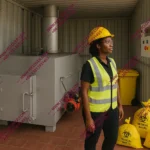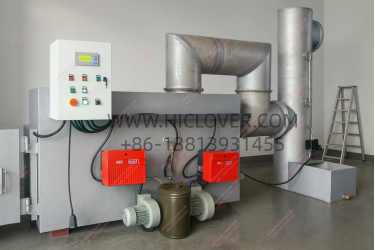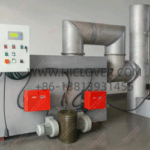Doubel Combustion Chamber
All Incinerators are Doubel Combustion Chamber with One Fuel Burner Each. After Burner Technology for Completely Combustion and Cleaner World.
Read MoreHigh Temperature Incineration
Temperature Range 800 Degree to 1200 Degree in Combustion Chamber. Temperature Thermocouple Monitor and Controller. High Quality Fire Brick and Refactory Cement.
Read MoreGet Lastest News
There are latest incinerator news like technical, public news, business tender for medical waste incinerator,animal incineration, pet cremation
Read MoreNanjing Clover Medical Technology Co.,Ltd.
Email: sales@clover-incinerator.com | Tel: +86-25-8461 0201
Regular model incinerator for market with burning rate from 10kgs to 500kgs per hour and we always proposal customer send us their require details, like waste material, local site fuel and power supply, incinerator operation time, etc, so we can proposal right model or custom made with different structure or dimensions.
Incinerator Model YD-100 is a middle scale incineration machine for many different usage: for a middle hospital sickbed below 500 units, for all small or big size family pets (like Alaskan Malamute Dog), for community Municipal Solid Waste Incineration, etc. The primary combustion chamber volume is 1200Liters (1.2m3) and use diesel oil or natural gas fuel burner original from Italy.
Latest Post
Mobile Incineration Solutions for Coal Mines and Open-Pit Mining Operations
Mobile Incineration Solutions for Coal Mines and Open-Pit Mining Operations
Mining activities―whether in underground coal mines, open-pit extraction areas, or explosive storage zones―generate a diverse range of waste types that require safe, efficient, and mobile treatment solutions. Waste from canteens, explosive packaging, oil-stained tarpaulins, and used protective clothing cannot be safely buried or burned openly. The mobile dual-chamber incinerator from HICLOVER provides a practical and compliant solution designed specifically for remote mining environments.
Challenges in Waste Disposal at Mining Sites
In coalfields across regions such as Inner Mongolia, South Africa, and Western Australia, mine operations are spread across wide and often shifting areas. Camps and work zones frequently move as new shafts or pits are developed. This mobility complicates waste collection and disposal. Transporting waste long distances is costly, and local dumping can contaminate groundwater and attract vermin.
For explosives warehouses and fuel depots, environmental safety requirements are even stricter. Open burning risks ignition, while storing combustible waste near operational zones violates most mine safety and environmental codes.
HICLOVER Mobile Dual-Chamber Incinerator
The mobile dual-chamber incinerator is built on a thermal-insulated trailer chassis, allowing it to be easily towed between mining sites. It includes two combustion chambers:
-
Primary Chamber C Designed for mixed solid waste such as oily cloth, packaging, and organic material.
-
Secondary Chamber C Operates above 1100°C, ensuring full burnout of gases and particulates for clean emissions.
Each system is diesel-fueled or optionally LPG-compatible, featuring PLC temperature control, automatic ignition, and stainless-steel stack for durability.
Learn more about key system components:
Why Mobility Matters for Mining Operations
Mines expand and relocate as extraction progresses. Permanent waste treatment plants are not cost-effective in these transient settings. HICLOVER’s trailer-mounted incinerator can be deployed directly beside underground dormitories, canteens, or maintenance areas, eliminating waste transport needs and improving hygiene on-site.
Key benefits include:
-
Rapid deployment without civil works.
-
Heat-insulated trailer base suitable for high-altitude or cold-climate mines.
-
Compact footprint, ideal for confined camp layouts.
-
Low fuel consumption, supporting continuous operation with minimal maintenance.
-
Emission compliance with GB18484-2020 and WHO field standards.
Environmental and Operational Advantages
Mining companies in areas such as Zambia’s Copperbelt, Indonesia’s coal basins, and Kazakhstan’s open-pit fields increasingly face scrutiny from local environmental authorities. Adopting self-contained mobile incineration units helps ensure compliance, improves worker safety, and demonstrates environmental responsibility.
Paired with optional wet scrubbers or activated carbon filtration systems, HICLOVER solutions minimize visible smoke and odor, meeting modern environmental expectations even in remote industrial zones.
Explore more sustainable waste handling systems:
HICLOVER ― Portable, Durable, and Compliant Waste Incineration for Global Mining and Resource Operations.
2025-11-03/14:22:34
|
Incinerator Items/Model |
HICLOVER TS100(PLC)
|
|
Burn Rate (Average) |
100kg/hour |
|
Feed Capacity(Average) |
150kg/feeding |
|
Control Mode |
PLC Automatic |
|
Intelligent Sensor |
Continuously Feeding with Worker Protection |
|
High Temperature Retention(HTR) |
Yes (Adjustable) |
|
Intelligent Save Fuel Function |
Yes |
|
Primary Combustion Chamber |
1200Liters(1.2m3) |
|
Internal Dimensions |
120x100x100cm |
|
Secondary Chamber |
600L |
|
Smoke Filter Chamber |
Yes |
|
Feed Mode |
Manual |
|
Burner Type |
Italy Brand |
|
Temperature Monitor |
Yes |
|
Temperature Thermometer |
Corundum Probe Tube, 1400℃Rate. |
|
Temperature Protection |
Yes |
|
Automatic Cooling |
Yes |
|
Automatic False Alarm |
Yes |
|
Automatic Protection Operator(APO) |
Yes |
|
Time Setting |
Yes |
|
Progress Display Bar |
3.7 in” LCD Screen |
|
Oil Tank |
200L |
|
Chimney Type |
Stainless Steel 304 |
|
1st. Chamber Temperature |
800℃–1000℃ |
|
2nd. Chamber Temperature |
1000℃-1300℃ |
|
Residency Time |
2.0 Sec. |
|
Gross Weight |
7000kg |
|
External Dimensions |
270x170x190cm(Incinerator Main Body) |
|
Burner operation |
Automatic On/Off |
|
Dry Scrubber |
Optional |
|
Wet Scrubber |
Optional |
|
Top Loading Door |
Optional |
|
Asbestos Mercury Material |
None |
|
Heat Heart Technology(HHT) |
Optional |
|
Dual Fuel Type(Oil&Gas) |
Optional |
|
Dual Control Mode(Manual/Automatic) |
Optional |
|
Temperature Record |
Optional |
|
Enhanced Temperature Thermometer |
Optional |
|
Incinerator Operator PPE Kits |
Optional |
|
Backup Spare Parts Kits |
Optional |
|
Mobile Type |
Optional:Containerized/Trailer/Sledge Optional |
PUF Waste Management in the EACOP Project C The Role of Industrial Incineration Solutions
PUF Waste Management in the EACOP Project C The Role of Industrial Incineration Solutions
The East African Crude Oil Pipeline (EACOP) is one of the most significant infrastructure developments in Sub-Saharan Africa, connecting Uganda’s Lake Albert oil fields to the port of Tanga in Tanzania. The project involves extensive engineering, procurement, and construction (EPC) work across multiple regions, creating a need for efficient, environmentally responsible waste management solutions during both construction and operation.
Among the materials used in pipeline insulation, polyurethane foam (PUF) plays a vital role in maintaining thermal stability along the heated pipeline. However, during production, transportation, and field installation, large volumes of PUF waste are generated that require careful handling and disposal.
1. PUF Waste in Oil and Gas Infrastructure Projects
PUF is widely used in oil pipeline systems for its excellent thermal insulation, chemical resistance, and lightweight properties. During pipeline construction and insulation work, PUF waste arises from:
-
Offcuts, trimming residues, and rejected foam sections.
-
Field joint insulation work, including foaming and cutting waste.
-
Empty drums, chemical residues, and contaminated packaging.
-
Absorbent materials or debris contaminated with insulation chemicals.
Although PUF waste appears inert, it is highly flammable and often contains residual blowing agents such as n-pentane, which can release volatile gases. For environmental and safety reasons, open burning or landfill disposal of this material is strictly discouraged. Controlled high-temperature incineration is the most effective and compliant method for treating this waste stream.
2. The Challenge of Low-Density Foam Waste
PUF waste has a very low bulk density, often below 80 kg/m3, meaning it occupies a large volume despite its low mass. This makes logistics, storage, and combustion inefficient.
To optimize disposal, the waste must first be shredded and compacted, increasing its density to around 150 kg/m3. Once compacted, it can be efficiently incinerated in a controlled combustion chamber designed for lightweight, high-calorific materials.
For large-scale EPC projects such as EACOP, the selected waste treatment system must be:
-
Portable and modular, suitable for relocation along the pipeline route.
-
Environmentally compliant, meeting World Bank, IFC, and local environmental standards.
-
Efficient in reducing waste volume and minimizing auxiliary fuel consumption.
3. Application of Containerized Incineration Systems
Containerized or modular incineration units are increasingly used in major energy and infrastructure projects to manage site-generated waste like PUF foam. These systems integrate all combustion and emission control stages within a compact, transportable design, making them ideal for temporary or multi-site projects.
Their key operational advantages include:
-
Mobility: Easy to deploy, relocate, and commission at different project zones.
-
Safety: Fully enclosed combustion chambers prevent fire hazards and uncontrolled emissions.
-
Efficiency: Optimized airflow and burner control enable stable combustion of low-density waste.
-
Environmental protection: Multi-stage flue gas cleaning ensures emissions meet international standards.
Such mobile incineration systems offer a reliable, practical, and regulatory-compliant solution for managing industrial waste directly at project sites without the need for long-distance waste transport.
4. Environmental Compliance and Sustainability
EACOP’s environmental management framework emphasizes sustainability, waste minimization, and pollution control throughout its operational lifecycle. Proper thermal treatment of PUF waste supports these principles by:
-
Eliminating hazardous residues and flammable materials.
-
Converting solid waste into inert ash and clean gases.
-
Achieving up to 95% volume reduction, reducing the environmental footprint.
By incorporating controlled incineration into the project’s environmental management plan, EACOP aligns with international ISO 14001 standards and the World Bank Environmental, Health, and Safety (EHS) Guidelines, ensuring responsible waste disposal practices in both Uganda and Tanzania.
5. Conclusion
The EACOP project highlights how large-scale energy infrastructure can balance industrial progress with environmental stewardship. PUF waste, though essential to pipeline insulation, presents unique challenges due to its high flammability and low density.
Through the adoption of high-temperature, containerized incineration systems, the project ensures efficient and compliant waste management―reducing environmental risks, ensuring worker safety, and supporting the region’s broader sustainability objectives.
Keywords: EACOP, polyurethane foam waste, PUF incineration, oil and gas waste management, containerized incinerator, EPC waste treatment, industrial waste disposal, environmental compliance, sustainable infrastructure, thermal insulation waste.
Modern Medical Waste Incinerators Strengthen Health and Environmental Safety in Africa
Modern Medical Waste Incinerators Strengthen Health and Environmental Safety in Africa
[City] C [Date] C With healthcare systems across Africa under pressure to safely manage hazardous medical waste, modern high-temperature incineration technology is becoming an essential part of hospital and research infrastructure. In countries such as Cameroon, Senegal, Togo, Guinea Equatorial, and Mali, hospitals and public health programs are now prioritizing professional incineration systems to protect both communities and the environment.
One proven solution is the HICLOVER TS Series. The TS100 (100 kg/hour) and TS200 (200 kg/hour) models are specifically engineered for the realities of African healthcare systems, where waste streams often include high-moisture infusion bags, PVC-based plastics, and sharps. Each system features a primary combustion chamber with refractory lining and a secondary chamber at 1100°C with a minimum two-second gas retention, ensuring complete destruction of infectious materials.
To meet growing international requirements, the systems can also be equipped with advanced smoke emission control technology, including wet scrubbers, quench towers, activated carbon adsorption, and baghouse filters. These options are particularly relevant for projects funded by the World Bank, WHO, and UNDP, which require compliance with strict environmental standards.
“Across Central and West Africa, demand for safe, reliable, and donor-compliant waste treatment solutions is rising quickly,” said a spokesperson for HICLOVER. “Our containerized and mobile units are designed to serve hospitals, university health centers, and humanitarian programs, even in remote or resource-limited locations.”
From urban hospitals in Malabo and Dakar to regional clinics in Bamako and Douala, the adoption of professional medical waste incinerators marks a significant step forward in public health protection and environmental sustainability.
For specifications and project support:
www.hiclover.com
sales@hiclover.com
High-Capacity Medical Waste Incineration Solutions in Malawi and Southern Africa
High-Capacity Medical Waste Incineration Solutions in Malawi and Southern Africa
Growing Demand for Safe Waste Treatment
Across Malawi and neighboring Southern African countries, the expansion of medical research institutions, teaching hospitals, and regional clinics has created a pressing demand for reliable medical waste incinerators. These facilities generate diverse hazardous waste streams—syringes, infusion sets, contaminated plastics, and laboratory samples—that require high-temperature destruction to meet both local and international environmental standards.
Traditional waste disposal practices such as open burning or uncontrolled landfilling no longer meet the requirements of modern healthcare. Institutions are therefore seeking professional incineration systems with capacities up to 200 kg per hour, capable of processing large volumes of waste on-site in a safe and sustainable manner.
Why Choose the HICLOVER TS200?
The HICLOVER TS200 medical waste incinerator has been specifically engineered for high-demand facilities in regions like Malawi. With a burn rate of 200 kg/hour, it is ideally suited for research institutions, district hospitals, and universities that require consistent throughput and compliance with international standards.
Key Technical Features
-
Primary Combustion Chamber: 1,980 liters with high-grade refractory lining to withstand continuous operations.
-
Secondary Combustion Chamber: 800 liters, maintaining ≥1100°C with a minimum 2-second retention time for flue gases, ensuring destruction of dioxins and furans.
-
Fuel Flexibility: Operates on diesel, natural gas, or LPG depending on local availability.
-
PLC Control System: Automated ignition, temperature monitoring, and air distribution for operator safety and efficiency.
-
Emission Control Options:
-
Wet Scrubber System for acid gas removal (HCl, SO₂).
-
Secondary Wet Scrubber with cooling, washing, and defogging.
-
Advanced Package with quench tower, activated carbon dosing, and baghouse filter for donor-funded projects requiring strict compliance.
-
Relevance to Malawi and Southern Africa
-
Urban Centers (Lilongwe, Blantyre): Hospitals and labs require on-site incinerators to manage daily waste safely.
-
Rural and District Clinics: Containerized versions of TS200 offer rapid deployment and ease of operation in remote areas.
-
Research Facilities: High-capacity incinerators ensure that sensitive biomedical samples are destroyed without risk of contamination or reuse.
-
Donor-Supported Projects: Many international health initiatives in Southern Africa mandate WHO-compliant waste treatment, which TS200 can deliver with optional emission control packages.
In local context:
“Katika Malawi, mahitaji ya vifaa vya kisasa vya kuchoma taka za hospitali yanaongezeka haraka”
(Swahili: In Malawi, the demand for modern medical waste incinerators is rapidly increasing).
Conclusion
For Malawi and Southern Africa, the HICLOVER TS200 incinerator represents a robust, high-capacity solution to medical waste challenges. With its 200 kg/hour throughput, dual-chamber high-temperature system, and advanced smoke emission controls, it delivers a reliable answer for hospitals, research institutions, and health programs aiming for international compliance and sustainable waste management.
For specifications and procurement support:
www.hiclover.com
sales@hiclover.com
Rwanda Waste Management Incinerator Solutions with HICLOVER
Rwanda Waste Management Incinerator Solutions with HICLOVER
Rwanda has made significant progress in improving environmental infrastructure, yet hospital waste management remains a priority area. The government and donor agencies continue to fund projects to provide modern Rwanda waste management incinerator systems for hospitals, clinics, and district health centers. In this context, HICLOVER offers advanced containerized and stationary models designed to meet local conditions, donor requirements, and international health standards.
Rwanda Hospital Waste Incinerator with Automatic Ignition and Fuel Saving Mode
One of the core challenges for hospitals in Rwanda is balancing efficiency with operating cost. Facilities often have limited budgets for fuel and electricity, so incinerators must be optimized for both performance and sustainability. A Rwanda hospital waste incinerator with automatic ignition and fuel saving mode addresses this problem by incorporating intelligent controls.
The HICLOVER TS100 PLC model, for example, is equipped with:
-
Automatic ignition system for reliable start-up, eliminating the need for manual burner lighting.
-
Fuel-saving mode that shuts off burners once the chamber temperature is above the programmed threshold, relying on the waste’s calorific value to sustain combustion.
-
High temperature retention (HTR) with adjustable setpoints to ensure consistent 850C1200 °C operation.
-
PLC automatic control with dual manual/automatic mode for operator flexibility.
-
Italy-made Riello burners, which are known for efficiency and durability in healthcare waste applications.
These features ensure that hospitals in Kigali, Butare, and rural districts can operate incinerators with reduced fuel consumption, while still achieving WHO-recommended combustion efficiency and emissions compliance.
Maintenance and Riello G20LC Burner Parts
Keeping incinerators running smoothly in Rwanda’s healthcare network requires reliable maintenance and easy access to spare parts. HICLOVER supports this by stocking and supplying parts such as the Riello G20LC burner nozzle and electrode kit for incinerator maintenance. These components are critical for sustained burner performance:
-
Nozzle kit ensures correct fuel atomization for consistent flame quality.
-
Electrode kit provides reliable ignition, even under high operating cycles.
-
Regular replacement of these parts reduces downtime, prevents ignition failure, and extends burner life.
By maintaining a steady supply of these parts, HICLOVER ensures that hospitals and clinics can keep their incinerators operational without long interruptions.
Modular Waste Management Plant Design for Rwanda
In addition to standalone hospital units, Rwanda has expressed interest in modular waste treatment solutions that can scale with population growth and urban expansion. HICLOVER’s containerized incinerators fit this requirement, with options from 30 kg/hour small clinic units up to 200C300 kg/hour containerized plants suitable for referral hospitals or regional treatment hubs.
Containerized systems are especially practical in Rwanda’s terrain, as they can be delivered to remote areas without requiring permanent civil works. These plug-and-play solutions make it possible to establish waste treatment capacity rapidly, in line with Rwanda’s national health strategy.
Conclusion
Rwanda’s commitment to safe healthcare waste disposal creates opportunities for advanced incinerator technologies. HICLOVER delivers solutions tailored to these needs, from a Rwanda hospital waste incinerator with automatic ignition and fuel saving mode to large-scale Rwanda waste management incinerator projects. With reliable technology, dual-chamber high-temperature design, and accessible maintenance support such as the Riello G20LC burner nozzle and electrode kit, HICLOVER ensures hospitals, clinics, and health projects in Rwanda can operate sustainably and safely.
For more information on HICLOVER incinerators and spare parts support, visit:
Website: www.hiclover.com
Email: sales@hiclover.com
Mobile (WhatsApp): +86-13813931455
















